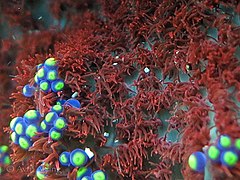
Sea anemones are the marine, predatory animals of the order Actiniaria. They are named after the anemone, a terrestrial flowering plant, because of the colourful appearance of many. Sea anemones are classified in the phylum Cnidaria, class Anthozoa, subclass Hexacorallia. As cnidarians, sea anemones are related to corals, jellyfish, tube-dwelling anemones, and Hydra. Unlike jellyfish, sea anemones do not have a medusa stage in their life cycle.

Condylactis gigantea is a tropical species of ball anemone that is found in shallow reefs and other shallow inshore areas in the Caribbean Sea – more specifically the West Indies – and the western Atlantic Ocean including southern Florida through the Florida Keys. It is also commonly known as: giant Caribbean sea anemone, giant golden anemone, condylactis anemone, Haitian anemone, pink-tipped anemone, purple-tipped anemone, and Florida condy. This species can easily be seen growing in lagoons or in inner reefs as either individuals or loose groups, but never as colonies. They are often used as a model organism along with others in their genus for facultative symbiosis with monocellular algae.

Stichodactyla helianthus, commonly known as sun anemone, is a sea anemone of the family Stichodactylidae. Helianthus stems from the Greek words ἡλιος, and ἀνθος, meaning flower. S. helianthus is a large, green, sessile, carpet-like sea anemone, from the Caribbean. It lives in shallow areas with mild to strong currents.

Lybia edmondsoni is a species of small crab in the family Xanthidae and is endemic to the Hawaiian Islands. Like other members of the genus Lybia, it is commonly known as the pom-pom crab or boxer crab because of its habit of carrying a sea anemone around in each of its claws, these resembling pom-poms or boxing gloves. Its Hawaiian name is kūmimi pua, meaning "inedible flower crab". In ancient times, this animal was used by men claiming to be sorcerers.

Calliactis parasitica is a species of sea anemone associated with hermit crabs. It lives in the eastern Atlantic Ocean and Mediterranean Sea at depths between the intertidal zone and 60 m (200 ft). It is up to 10 cm × 8 cm in size, with up to 700 tentacles, and is very variable in colour. The relationship between C. parasitica and the hermit crab is mutualistic: the sea anemone protects the hermit crab with its stings, and benefits from the food thrown up by the hermit crab's movements.

Epiactis prolifera, the brooding, proliferating or small green anemone, is a species of marine invertebrate in the family Actiniidae. It is found in the north-eastern Pacific. It has a feature rare among animals in that all individuals start life as females but develop testes later in their lives to become hermaphrodites.
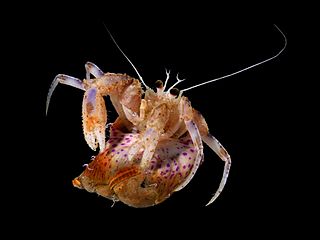
Adamsia palliata is a species of sea anemone in the family Hormathiidae. It is usually found growing on a gastropod shell inhabited by the hermit crab, Pagurus prideaux. The anemone often completely envelops the shell and because of this it is commonly known as the cloak anemone or the hermit-crab anemone.

Pagurus prideaux is a species of hermit crab in the family Paguridae. It is found in shallow waters off the northwest coast of Europe and usually lives symbiotically with the sea anemone Adamsia palliata.

Calliactis polypus is a species of sea anemone in the family Hormathiidae. It is usually found living on the surface of a sea snail shell in which a hermit crab is living.
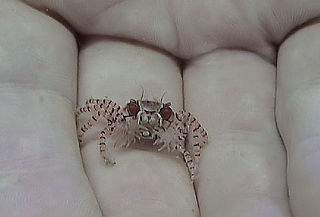
Triactis is a genus of sea anemone in the family Aliciidae. It is monotypic, having only one species – Triactis producta. This is found in shallow waters in the Indo-Pacific where it lives on the seabed, rocks and corals. It derives much of its energy needs from the symbiotic algae it contains. It also forms a mutualistic relationship with small Lybia crabs.

Lybia tessellata is a species of small crab in the family Xanthidae. It is found in shallow parts of the tropical Indo-Pacific Ocean. Like other members of the genus Lybia, it is commonly known as the pom-pom crab or boxer crab because of its habit of carrying a sea anemone around in each of its claws, these resembling pom-poms or boxing gloves.
Calliactis tricolor, the tricolor anemone or hitchhiking anemone, is a species of sea anemone in the family Hormathiidae. It occurs in the Caribbean Sea and the Gulf of Mexico. It can be found attached to rocks but is often attached to a living crab or mollusc or an empty shell occupied by a hermit crab.

Lebrunia neglecta is a species of sea anemone in the family Aliciidae. It is found in the Caribbean Sea and Gulf of Mexico.

Phyllodiscus is a monotypic genus of sea anemones in the family Aliciidae. The only species is Phyllodiscus semoni, commonly known as the night anemone, which is native to shallow seas in the central Indo-West Pacific, such as Indonesia, the Philippines and southern Japan. It is venomous and can cause a painful, long-lasting sting to humans. It is called unbachi-isoginchaku in Japanese which translates as "wasp-sea anemone".
Calitoxin, also known as CLX, is a sea anemone neurotoxin produced by the sea anemone Calliactis parasitica. It targets crabs and octopuses, among other invertebrates. Two isoforms have been identified, both of which are formed from precursors stored in the stinging cells of the anemone. Once the toxin is activated and released, it causes paralysis by increasing neurotransmitter release at invertebrate neuromuscular junctions. Along with several other toxins derived from anemones, CLX is useful in ion channel research. Certain structural aspects of calitoxin are dissimilar from sea anemone toxins that also target the sodium ion channels. Other toxins resembling calitoxin function in completely different ways.

The Enthemonae is a suborder of sea anemones in the order Actiniaria. It comprises those sea anemones with typical arrangement of mesenteries for actiniarians.
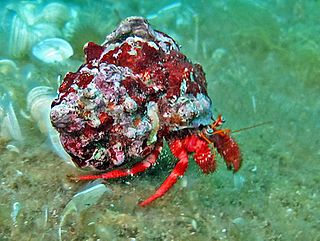
Dardanus arrosor, the red reef hermit or Mediterranean hermit crab, is a species of hermit crab.

Thalassianthidae is a family of sea anemones that contains the genera Actineria, Cryptodendrum,Heterodactyla, and Thalassianthus. These sea anemones do not host any varieties of clownfishes, but have been associated with some species of commensal anemone shrimp.
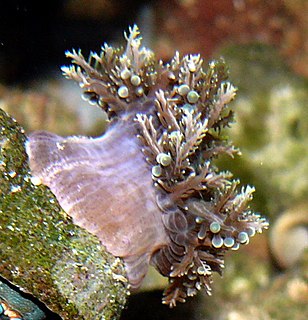
Thalassianthus is a genus of sea anemones of the family Thalassianthidae.

Aiptasia mutabilis, also known as the trumpet anemone, rock anemone, and glass anemone, is a species of anemone typically found attached to substrates in cold waters of the Atlantic Ocean. Its unique trumpet shape gives it its common name and it can grow to be 12 cm, having a column between 3 and 6 cm in size. Like many cnidarians, they rely on nematocysts for protection and to capture prey. They are not difficult to care for, and can be kept in a home aquarium, although due to their speed of reproduction, can quickly become overpopulated.




